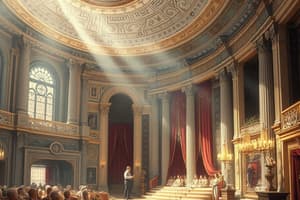Podcast
Questions and Answers
What was the Pleiade?
What was the Pleiade?
- An actress famous for neoclassical roles
- A group of 16th century French Renaissance poets and playwrights (correct)
- A type of French play
- A group of 17th century painters
What was ballet de cour?
What was ballet de cour?
Seeds of opera consisting of dramatic plot, song, dance, and spectacle.
What was the Confrerie de la Passion?
What was the Confrerie de la Passion?
An association of actors used for the presentation of religious plays.
What was the Hotel de Bourgogne?
What was the Hotel de Bourgogne?
Who was Cardinal Richelieu?
Who was Cardinal Richelieu?
Who is Alexandre Hardy?
Who is Alexandre Hardy?
What does Teatre du Marais refer to?
What does Teatre du Marais refer to?
Who was Pierre Corneille?
Who was Pierre Corneille?
What is 'Le Cid Controversy'?
What is 'Le Cid Controversy'?
What was the Academie Francaise?
What was the Academie Francaise?
Who was Jean-Baptiste Lully?
Who was Jean-Baptiste Lully?
What is Jean Racine known for?
What is Jean Racine known for?
Who is Moliere?
Who is Moliere?
Who was Armande Bejart?
Who was Armande Bejart?
What is Comedie Francais?
What is Comedie Francais?
Who was Montdory?
Who was Montdory?
What does Montfleury refer to?
What does Montfleury refer to?
Who was Floridor?
Who was Floridor?
Describe the layout of French theatre.
Describe the layout of French theatre.
What was the Interregnum?
What was the Interregnum?
What does the Commonwealth refer to?
What does the Commonwealth refer to?
Who was Oliver Cromwell?
Who was Oliver Cromwell?
Study Notes
French Renaissance and Neoclassical Theatre
-
Pleiade: A collective of 16th-century French poets and playwrights aiming to elevate French literature, inspired by classical works and led by Pierre de Ronsard.
-
Ballet de cour: Early form of opera combining dramatic plots, song, dance, and elaborate spectacle, showcasing the integration of various artistic elements.
-
Confrerie de la Passion: Actors' association monopolized the performance of religious plays in Paris, granted exclusive rights by Charles VI, excluding others from organizing plays.
-
Hotel de Bourgogne: Recognized as the first permanent theater structure in Europe following the fall of Rome, marking a significant development in theatrical venues.
Key Figures and Contributions
-
Cardinal Richelieu: Chief minister to the young Louis XIII, effectively controlled France until the king matured; instrumental in introducing Italian scenic innovations through Tomaso Francini.
-
Alexandre Hardy: Pioneering professional dramatist who wrote around 500 plays, of which 34 survive; known for engaging popular audiences and often disregarding neoclassical unities, focusing on comedies and pastoral themes.
-
Pierre Corneille: Prominent French tragedian, celebrated as one of the major dramatists of the 17th century alongside Moliere and Racine; credited with solidifying neoclassical ideals through his works.
-
Jean-Baptiste Lully: Founder of French opera, who gained a monopoly on musical performances and assumed control of Moliere's theatre, influencing the direction of theatrical music.
-
Jean Racine: Acclaimed for epitomizing French tragedy, Racine's works frequently draw from classical sources, with "Phédre" being one of his notable contributions closely aligned with neoclassical ideals.
-
Moliere: The greatest comic playwright of his time, originally named Jean-Baptiste Poquelin, Moliere created a successful theatre company and is known for his strong character development and plots rooted in neoclassical principles.
-
Armande Bejart: Noted as a leading French actress of the 17th century, she was also the wife of Moliere, contributing to the theatrical landscape of the era.
-
Comedie Francais: The first national theatre company, granted a monopoly on spoken word plays in French, while opera maintained a monopoly on musical performances.
Theatrical Innovations and Layout
-
Montdory: Recognized as the first exceptional French actor, setting the standard for dramatic performance in theatre.
-
Montfleury: The pseudonym of Zacharie Jacob, a notable actor and playwright who influenced the development of 17th-century French theatre.
-
Floridor: A significant French actor known for his versatility in comedy and tragedy, who assumed leadership of the Teatre de Marais after Montdory's retirement.
-
French Theatre layout: Characterized by raked stages and pits, small performances spaces, and the use of Italian scenic conventions such as wings, chariots, pulls, stock scenery, and borders.
Historical Context
-
The Interregnum (1642-1660): The period following the execution of Charles I, leading to the rise of Charles II and the restoration of the monarchy, significantly affecting theatre and arts.
-
The Commonwealth: The era during which England was governed without a king, where a committee appointed by Parliament managed the country’s affairs, resulting in the suppression of theatrical performances.
-
Oliver Cromwell: Lord Protector who ruled England with strict Puritan values, enforcing the closure of theatres and significantly curtailing public artistic expression during his regime.
Studying That Suits You
Use AI to generate personalized quizzes and flashcards to suit your learning preferences.
Description
Test your knowledge of key terms and concepts in French Neoclassical theatre. This quiz covers important groups, forms, and associations from the 16th century. Perfect for literature enthusiasts and students of theatre history.




